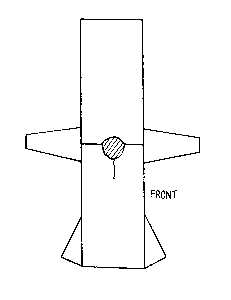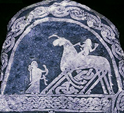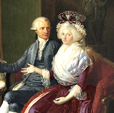Early Medieval Clothes Patterns
| The patterns and descriptions given here are intended for re-enactors rather than serious academic historians. Janet Arnold has written an excellent series of books which are based on disections of actual historical clothing from the 16th Century onwards and which give accurate patterns. Most of the evidence for Early Medieval clothing is in the form of fragments of garments and illustrations in manuscripts and other historical records, so there has to be a certain amount of guesswork involved in recreations. |
|
| SIMPLE T- TUNIC The pattern opposite can be used for a man's tunic or a woman's dress. Variations on this style were worn from the time of the Bronze Age. Arguably, the traditional peasant smock, which was worn in Britain up until the last century was an evolution of the garment. High class ladies began to wear fitted dresses which laced up the back in the 11th Century, and in the 13th Century fashionable men began to wear more fitted garments with buttons up the front. The front and back body pieces are simple rectangles. The triangular panels at the side can be attached with their top points level with either the waist or hip of the wearer. Approximately one third of the circle of the neck hole should be cut into the back of the tunic and two thirds at the front. |
 |
| The sleeves should be narrow at the wrist, but remember to leave room to get hands through them. Alternatively, for very tight fitting sleeves, use bead buttons or hooks to close the wrists rather than sewing the sleeves all the way down. It is easier to fit the sleeves on and make the neck hole with the tunic flat, as shown. Fold in half and sew the side seams and sleeves as the final stage in making the tunic. The tunic (or dress) may be decorated with embroidery, braid of various types and contrasting coloured fabrics. Patterns and fashions of decoration varied depending upon periods of history and geographical area. The usual materials used to make clothes would be linen or wool. Silk was imported during the medieval period but was rare and very expensive. Colours such as greens, yellows and browns were easy to achieve with native plants and simple dyeing processes, and so they would have been widely available to everyone. Reds would be more difficult to make. Blues could only be made with wode, which involved a complex dyeing process, or with indigo which had to be imported from India. Natural dyed fabrics can be reasonably bright colours, depending on the quality of the local water and the mordant (fixing agent) used. Mosses which were used as mordants in Scotland during the medieval period are now endangered species, but iron mordants can still be used today. |
|
 |
HOSE |
HOOD |
 |
See also - Medieval Stitches, the Vikings Society Basic Kit Guide, Evolution of the Kilt, The textiles in the Oseberg ship and Later medieval patterns |
|




